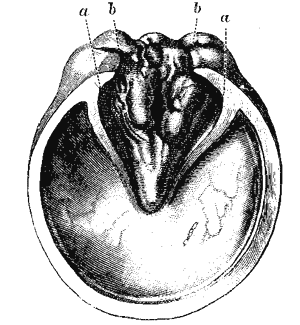Contracted foot
 By the term contracted foot, otherwise known as hoof-bound, is indicated a condition in which the foot, more especially the posterior half of it, is, or becomes, narrower from side to side than is normal.
By the term contracted foot, otherwise known as hoof-bound, is indicated a condition in which the foot, more especially the posterior half of it, is, or becomes, narrower from side to side than is normal.It must be borne in mind, however, that certain breeds of horses have normally a foot which nearer approaches the oval than the circular in form, and that a narrow foot is not necessarily a contracted foot.
The contraction may be bilateral when affecting both heels of the same foot and extending to the quarters, or unilateral when the inside or outside heel only is affected.
In some cases contraction is confined to one foot, while in others it may be noticed equally bad in both. It is a matter of common knowledge that contraction is usually seen in the fore-feet, while the hind seldom or never suffer from it, a fact which, to our minds, seems difficult of adequate explanation.
Zundel explains this by stating that contraction is principally observed in the fore-feet, by reason of the fact that when lameness arises from it alteration in action will more readily be detected in front than behind.
Percival, on the other hand, suggests that the greater expansive powers of the hind-foot, by reason of the impetus of its action, is able to overcome any influence operating towards contraction. It may be, however, that given a cause for contraction, such as the removal of the frog's counter-pressure with the ground by faulty shoeing or excessive paring, the fore-feet, by reason of their being called upon to bear the greater part of the body-weight, are the first to suffer.
Flat feet with weak heels are those most frequently affected, and, as we have already intimated, the condition may exist with or without other disease of the foot.
Depending upon its degree, contracted foot may vary from a simple abnormality, non-inflammatory and painless, to a condition in which it becomes a veritable disease, giving rise to a bad form of lameness, and bringing about a withered and sometimes discharging and cankerous affection of the frog.
Contracted foot symptoms
In its early stages contraction is difficult of detection, and where both feet are affected may for some time go unsuspected. With only one foot undergoing change, the early stages may the more readily be marked, for in this case comparison with the other and sound foot will at once reveal the alteration in shape. If lameness in the suspected foot is present, then any lingering doubt will be quickly dispelled.
When far advanced, contraction offers signs that cannot well be missed. The converging of the heels narrows the V-shaped indentation in the sole for the reception of the frog. As a consequence of this, the frog itself becomes atrophied by reason of the continual pressure exerted upon it by the ingrowing horn of the wall and the bars. The median and lateral lacunae of this organ, from being fairly broad and open channels, become pressed into mere crack-like openings (see the commencing of this condition in the picture on the right).
As the case goes on, the lateral branches of the frog entirely disappear, and all that is left of the organ is a remnant of its body or cushion, now wedged in tightly between the bars. Following upon the disappearance of the frog, we find that the bars are in contact, or, in some cases, actually overlapping each other at their posterior extremities.
At this stage, perhaps, the whole condition has become aggravated by a foul discharge from the place originally occupied by the frog, and the foot, especially in the region of the heels, has become hot and tender—really a form of local and subacute laminitis.
The long-continued inflammation, although only of a low type, renders the horn of the hoof hard and dry, and only with difficulty will the ordinary foot instruments cut it. This in its turn leads to cracks and fissures in various places, but more especially in the bars and what is left of the frog. Often, too, cracks will appear in the horn of the quarters, and a troublesome and incurable form of sand-crack results.
An animal with contraction advanced as far as this, especially if confined to one foot, goes unmistakably lame. With both feet affected, he ordinarily starts out from the stable in a manner that is commonly called 'groggy.' In other words, the gait is uncertain, and feeling; and stumbling is frequent.